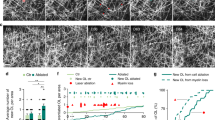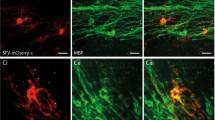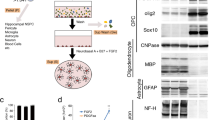Abstract
Axons of various hippocampal neurons are myelinated mainly postnatally, which is important for the proper function of neural circuits. Demyelination in the hippocampus has been observed in patients with multiple sclerosis, Alzheimer's disease or temporal lobe epilepsy. However, very little is known about the mechanisms and exact functions of the interaction between the myelin-making oligodendrocytes and the axons within the hippocampus. This is mainly attributable to the lack of a system suitable for molecular studies. We recently established a new myelin coculture from embryonic day (E) 18 rat embryos consisting of hippocampal neurons and oligodendrocytes, with which we identified a novel intra-axonal signaling pathway regulating the juxtaparanodal clustering of Kv1.2 channels. Here we describe the detailed protocol for this new coculture. It takes about 5 weeks to set up and use the system. This coculture is particularly useful for studying myelin-mediated regulation of ion channel trafficking and for understanding how neuronal excitability and synaptic transmission are regulated by myelination.
This is a preview of subscription content, access via your institution
Access options
Subscribe to this journal
Receive 12 print issues and online access
$259.00 per year
only $21.58 per issue
Buy this article
- Purchase on Springer Link
- Instant access to full article PDF
Prices may be subject to local taxes which are calculated during checkout





Similar content being viewed by others
References
Dotti, C.G., Sullivan, C.A. & Banker, G.A. The establishment of polarity by hippocampal neurons in culture. J. Neurosci. 8, 1454–1468 (1988).
Craig, A.M. & Banker, G. Neuronal polarity. Annu. Rev. Neurosci. 17, 267–310 (1994).
Horton, A.C. & Ehlers, M.D. Neuronal polarity and trafficking. Neuron 40, 277–295 (2003).
Dotti, C.G. & Banker, G.A. Experimentally induced alteration in the polarity of developing neurons. Nature 330, 254–256 (1987).
Sampo, B., Kaech, S., Kunz, S. & Banker, G. Two distinct mechanisms target membrane proteins to the axonal surface. Neuron 37, 611–624 (2003).
Wisco, D. et al. Uncovering multiple axonal targeting pathways in hippocampal neurons. J. Cell Biol. 162, 1317–1328 (2003).
Gu, C., Jan, Y.N. & Jan, L.Y. A conserved domain in axonal targeting of Kv1 (Shaker) voltage-gated potassium channels. Science 301, 646–649 (2003).
Gu, C. et al. The microtubule plus-end tracking protein EB1 is required for Kv1 voltage-gated K+ channel axonal targeting. Neuron 52, 803–816 (2006).
Barry, J., Gu, Y. & Gu, C. Polarized targeting of L1-CAM regulates axonal and dendritic bundling in vitro. Eur. J. Neurosci. 32, 1618–1631 (2010).
Gu, Y. & Gu, C. Dynamics of Kv1 channel transport in axons. PLoS ONE 5, e11931 (2010).
Horton, A.C. et al. Polarized secretory trafficking directs cargo for asymmetric dendrite growth and morphogenesis. Neuron 48, 757–771 (2005).
Hayashi, T., Thomas, G.M. & Huganir, R.L. Dual palmitoylation of NR2 subunits regulates NMDA receptor trafficking. Neuron 64, 213–226 (2009).
Ryu, J. et al. A critical role for myosin IIb in dendritic spine morphology and synaptic function. Neuron 49, 175–182 (2006).
Williams, M.E. et al. Cadherin-9 regulates synapse-specific differentiation in the developing hippocampus. Neuron 71, 640–655 (2011).
Arnold, S.E. & Trojanowski, J.Q. Human fetal hippocampal development: I. Cytoarchitecture, myeloarchitecture, and neuronal morphologic features. J. Comp. Neurol. 367, 274–292 (1996).
Haber, M., Vautrin, S., Fry, E.J. & Murai, K.K. Subtype-specific oligodendrocyte dynamics in organotypic culture. Glia 57, 1000–1013 (2009).
Dutta, R. et al. Demyelination causes synaptic alterations in hippocampi from multiple sclerosis patients. Ann. Neurol. 69, 445–454 (2011).
Noble, M. The possible role of myelin destruction as a precipitating event in Alzheimer's disease. Neurobiol. Aging 25, 25–31 (2004).
Dawodu, S. & Thom, M. Quantitative neuropathology of the entorhinal cortex region in patients with hippocampal sclerosis and temporal lobe epilepsy. Epilepsia 46, 23–30 (2005).
Chambers, J.S. & Perrone-Bizzozero, N.I. Altered myelination of the hippocampal formation in subjects with schizophrenia and bipolar disorder. Neurochem. Res. 29, 2293–2302 (2004).
Chan, J.R. et al. NGF controls axonal receptivity to myelination by Schwann cells or oligodendrocytes. Neuron 43, 183–191 (2004).
Watkins, T.A., Emery, B., Mulinyawe, S. & Barres, B.A. Distinct stages of myelination regulated by gamma-secretase and astrocytes in a rapidly myelinating CNS coculture system. Neuron 60, 555–569 (2008).
Nash, B. et al. Functional duality of astrocytes in myelination. J. Neurosci. 31, 13028–13038 (2011).
Thomson, C.E. et al. Myelinated, synapsing cultures of murine spinal cord—validation as an in vitro model of the central nervous system. Eur. J. Neurosci. 28, 1518–1535 (2008).
Lubetzki, C. et al. Even in culture, oligodendrocytes myelinate solely axons. Proc. Natl. Acad. Sci. USA 90, 6820–6824 (1993).
Xu, M., Cao, R., Xiao, R., Zhu, M.X. & Gu, C. The axon-dendrite targeting of Kv3 (Shaw) channels is determined by a targeting motif that associates with the T1 domain and ankyrin G. J. Neurosci. 27, 14158–14170 (2007).
Xu, M., Gu, Y., Barry, J. & Gu, C. Kinesin I transports tetramerized Kv3 channels through the axon initial segment via direct binding. J. Neurosci. 30, 15987–16001 (2010).
Gu, Y., Barry, J., McDougel, R., Terman, D. & Gu, C. Alternative splicing regulates kv3.1 polarized targeting to adjust maximal spiking frequency. J. Biol. Chem. 287, 1755–1769 (2012).
Kaech, S. & Banker, G. Culturing hippocampal neurons. Nat. Protoc. 1, 2406–2415 (2006).
Gu, C. & Gu, Y. Clustering and activity tuning of Kv1 channels in myelinated hippocampal axons. J. Biol. Chem. 286, 25835–25847 (2011).
Gu, C. & Barry, J. Function and mechanism of axonal targeting of voltage-sensitive potassium channels. Prog. Neurobiol. 94, 115–132 (2011).
Jiang, M. & Chen, G. High Ca2+-phosphate transfection efficiency in low-density neuronal cultures. Nat. Protoc. 1, 695–700 (2006).
Acknowledgements
We thank J. Barry and Y. Gu for technical assistance, and the Campus Microscopy & Imaging facility at the Ohio State University and Research Core Services at Lerner Research Institute of Cleveland Clinic Foundation for technical assistance in transmission electron microscopy. This work was supported by a career transition fellowship award from the US National Multiple Sclerosis Society (grant TA3012A1) and a grant from the US National Institute of Neurological Disorders and Stroke/National Institutes of Health (R01NS062720) to C.G. All animal experiments have been conducted in accordance with the US National Institutes of Health Animal Use Guidelines.
Author information
Authors and Affiliations
Contributions
A.G. and C.G. designed and performed the experiments. A.G., P.J. and C.G. wrote the manuscript. C.G. supervised the project.
Corresponding author
Ethics declarations
Competing interests
The authors declare no competing financial interests.
Rights and permissions
About this article
Cite this article
Gardner, A., Jukkola, P. & Gu, C. Myelination of rodent hippocampal neurons in culture. Nat Protoc 7, 1774–1782 (2012). https://doi.org/10.1038/nprot.2012.100
Published:
Issue Date:
DOI: https://doi.org/10.1038/nprot.2012.100
This article is cited by
-
Immediate induction of varicosities by transverse compression but not uniaxial stretch in axon mechanosensation
Acta Neuropathologica Communications (2022)
-
Region-specific interneuron demyelination and heightened anxiety-like behavior induced by adolescent binge alcohol treatment
Acta Neuropathologica Communications (2019)
-
Leukocyte expression profiles reveal gene sets with prognostic value for seizure-free outcome following stereotactic laser amygdalohippocampotomy
Scientific Reports (2019)
-
Pre-culture Sudan Black B treatment suppresses autofluorescence signals emitted from polymer tissue scaffolds
Scientific Reports (2017)
-
Neurons define non-myelinated axon segments by the regulation of galectin-4-containing axon membrane domains
Scientific Reports (2017)
Comments
By submitting a comment you agree to abide by our Terms and Community Guidelines. If you find something abusive or that does not comply with our terms or guidelines please flag it as inappropriate.



